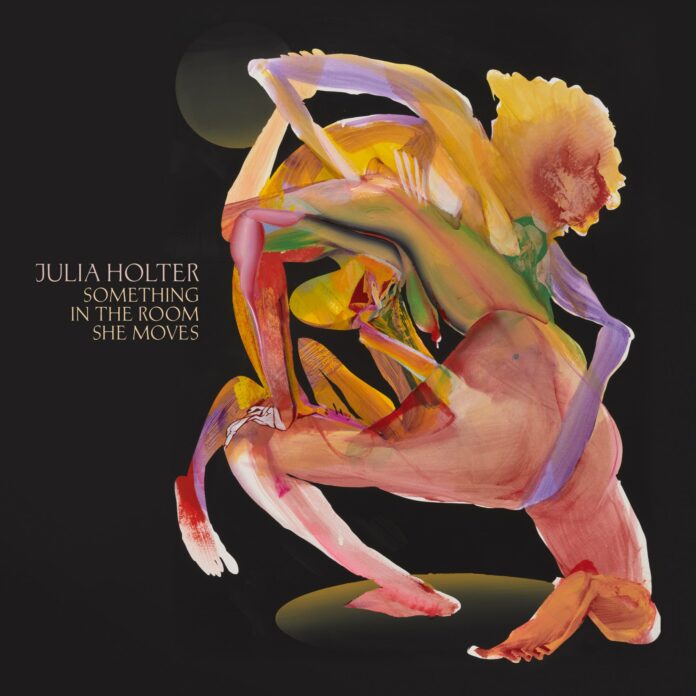One of the inspirations behind Julia Holter’s Something in the Room She Moves is French feminist theorist Hélène Cixous’ 1996 essay ‘Writing Blind’, which explores the relationship between her writing, creativity, and the night. “What we call the day prevents me from seeing,” it begins. “Solar daylight blinds me to the visionary day. The blaze of day prevents me from hearing. From seeing and hearing. From hearing myself. Along with me. Along with you. Along with the mysteries.” To write is to go looking for the secrets hidden in broad daylight, what Cixous calls “the skin of light.” In another essay from the same book, Stigmata, Cixous compares writing to music, the night vibrating in its frequencies: “I see with my ears, I advance into the bosom of the world, hands in front, capturing the music with my palms, until something breathes under the pen’s beak.” It is that something Holter is after and refers to on her new album – not only for its intensity, but because she understands it is “the same night in which love is made, in which things merge, change, become enchanted, aroused, impregnated, possessed, released, renewed,” as Virginia Wolf wrote.
The songs that gleam and sparkle, ‘Sun Girl’ and ‘Spinning’, stand out, making them the obvious choices for singles. But even they are coloured by the improvisational qualities and playful fluidity of Holter’s musical approach. ‘Sun Girl’ is the most pop-focused track on the album, capturing a warmth it almost instinctively, but gleefully, jerks away from, meandering into a celestial melody for the chorus and towards the chaos that hovers in the spaces between. It toes the line between the childlike and the dreamlike, which Holter interprets as a state of rapture. ‘Spinning’, the album’s euphoric centerpiece, is even more unnerved, itching to replace the blinding force of light with that of darkness, where imagination can run wild: “Believe in night that breathes alone/ Distinct at night/ Swoop in to fill my arms/ At night.” The lyrics of ‘These Morning’ ambiguously hint at human conflict, but Holter takes the opportunity to luxuriate in the languor of the night in which she has escaped, where words become blurred and drift like time, slowly and incomprehensibly.
Though steeped in abstraction, there is a stark physicality to Something in the Room She Moves, which stands as one of the most sensual and somatic works in Holter’s career. Though the music glides in different directions, she never strays from the central goal of “evoking the body’s internal sound world.” ‘Evening Mood’ features a sample of an ultrasound session Holter recorded when she was still pregnant with her daughter while mirroring the surge of oxytocin that floods the mother’s system; the rush is what music gorgeously conveys, but the heartbeat provides the reason. “Am I listening close, my love?” she sings, not leaning forward so much as tuning into the rhythm of bodies existing and growing together. The intimacy is so simple and natural that all Holter needs is a single phrase to create one of the album’s most striking moments, vocalizing the title of ‘Meyou’ in a way that renders the merging of the two subjects as a meditative dance. In the cover art by Holter’s childhood friend, the artist Christina Quarles, you can’t quite tell if the figures are embracing or battling; here, there’s no such question.
Whether breezy, dizzying, soothing, or bombastic, Holter’s output has always been immersive, and her latest is, too; what she does differently is remove the distance from the people, spaces, and ideas she interacts with. Straying from the maximalism of the singles, ‘Materia’ is just Holter and her Wurlitzer, an affecting composition despite its elusive poetry, while ‘Ocean’ builds an entire soundscape out of the aquatic elements permeating the record. She’s not observing a body of water or the room she finds herself in; she inhabits and burrows deep inside them, pacing with what the title track describes as “frantic wonder.” “In the past my records were more focused on the past or the future, about love from afar, as maybe more of an ethereal thing,” Holter remarked in an interview. But Something in the Room sees the present as an endless stream – of days and nights, of unresolved mysteries, of love and grief entwined – and keeps its hands outstretched for everything that passes through it. “Heaven can’t take my love,” she pleads on ‘Talking to the Whisper’, the arrangement rumbling and shrieking at the thought, yet not quite restrained by it. It’s a nocturnal record that doesn’t fear the morning ahead, ending with an ode to “my love waking up my every day.” Holter guides us along each passage; all you have to do is listen.

